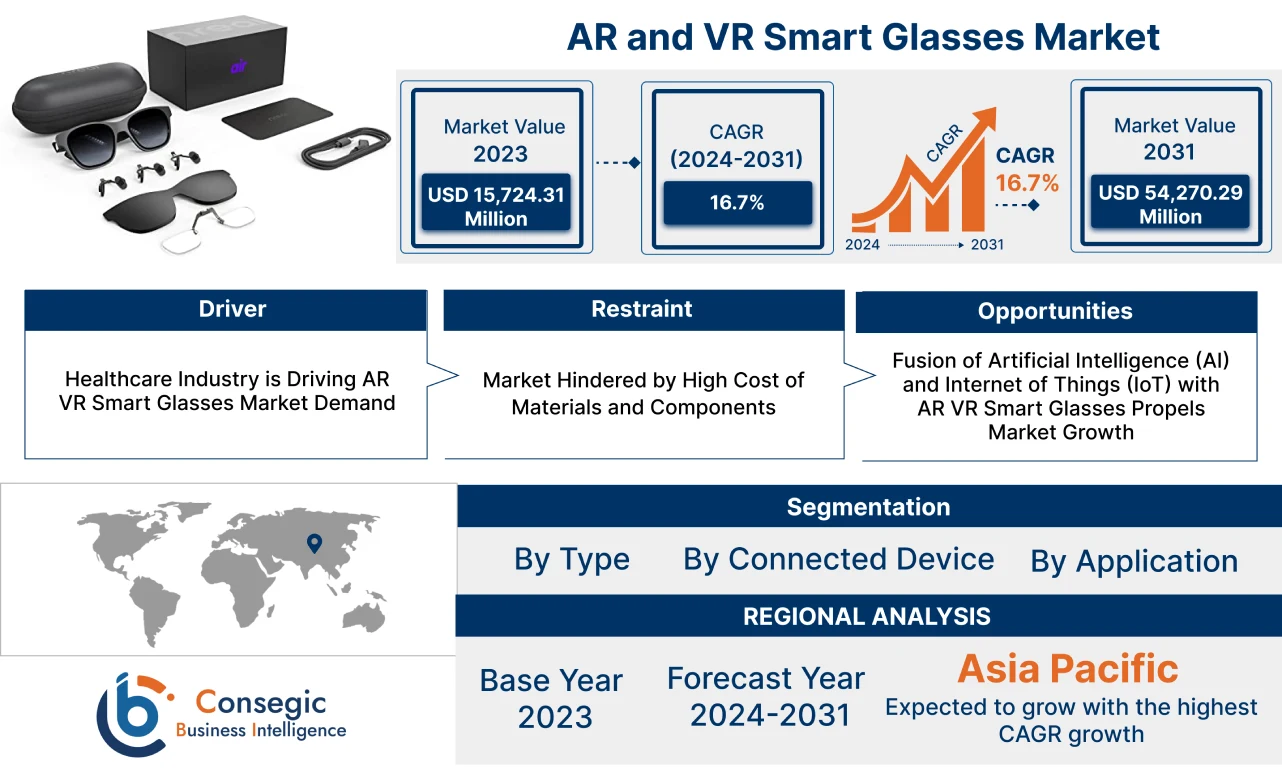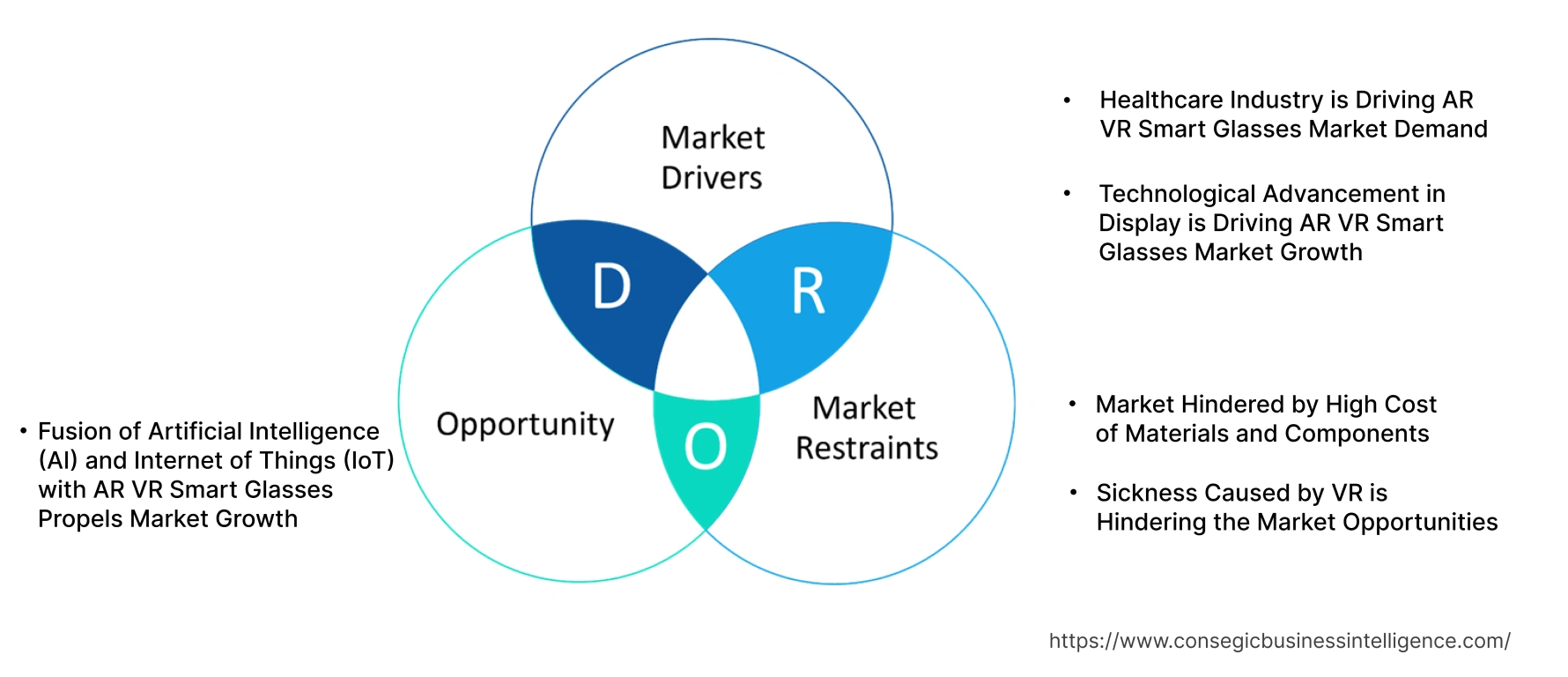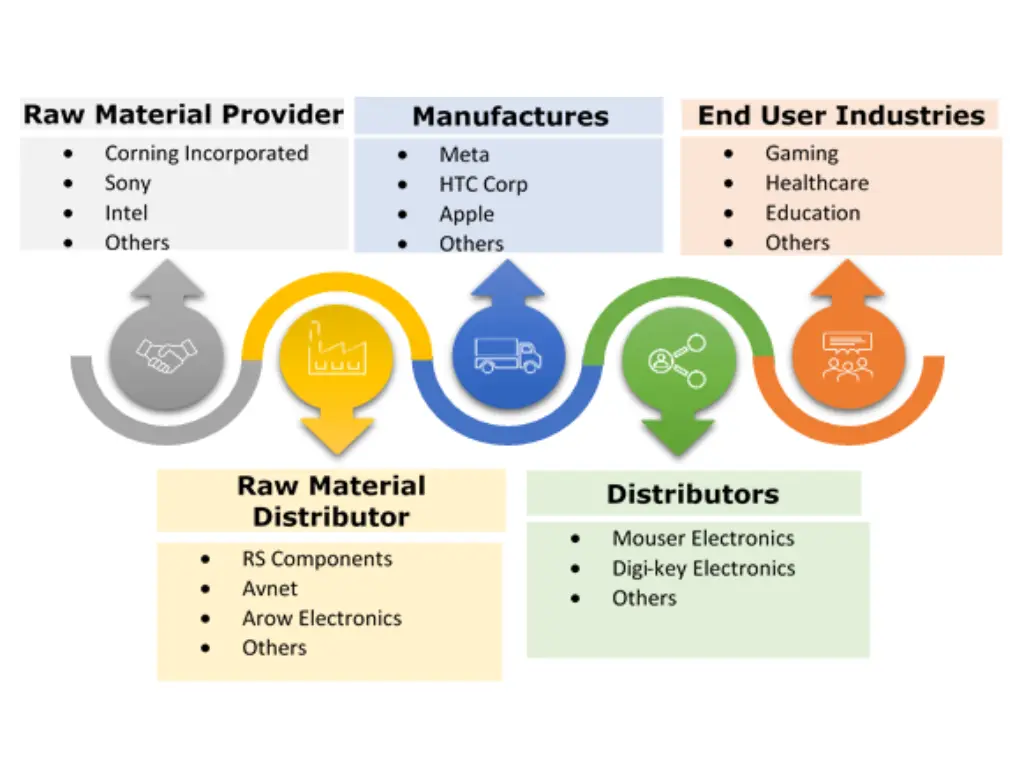- Summary
- Table Of Content
- Methodology
AR and VR Smart Glasses Market Size:
Global AR and VR Smart Glasses Market size is estimated to reach over USD 54,270.29 Million by 2031 from a value of USD 15,724.31 Million in 2023 and is projected to grow by USD 18,077.61 Million in 2024, growing at a CAGR of 16.7% from 2024 to 2031.
AR and VR Smart Glasses Industry Scope & Overview:
AR (Augmented Reality) and VR (Virtual Reality) smart glasses are wearable near-eye devices that create a simulation of any environment and overlay digital information onto the physical world, enhancing user experiences and interactions. They have applications across various fields, such as gaming, entertainment, healthcare, and industrial training. Moreover, these glasses come with features like 3D display, head tracking, and gesture recognition, providing an immersive and interactive experience. Additionally, the benefits include hands-free operation, real-time data access, and improved productivity. They are widely used in industries like manufacturing, healthcare, and education. Furthermore, the increasing demand for remote collaboration and training in various industries is the driving factor for these glasses. In the post-pandemic world, they enable virtual presence, allowing individuals to interact and collaborate in a shared virtual environment despite geographical distances. This not only enhances communication and productivity but also reduces travel costs and time, making it a compelling solution for businesses worldwide.
AR and VR Smart Glasses Market Insights:
Key Drivers:
Healthcare Industry is Driving AR and VR Smart Glasses Market Demand
The healthcare industry is significantly contributing to the need for these smart glasses. These technologies are revolutionizing healthcare by enhancing patient treatment, surgery planning, medical education, and nursing staff training. Devices like head-mounted displays, smart glasses, and 3D sensors are widely used in various applications such as training, surgeries, diagnostics, and telementoring.
- In April 2024, the U.S. Food and Drug Administration launched a new initiative, Home as a Health Care Hub, aimed at transforming the home into a key component of the healthcare system and promoting health equity for all U.S. residents.
Hence, the healthcare industry and the increasing adoption of AR and VR technologies are driving the AR and VR smart glasses market demand.
Technological Advancement in Display is Driving AR and VR Smart Glasses Market Growth
Advancements in display technology such as OLED and Micro LED, have improved the visual experience of these smart glasses. They offer high-resolution displays crucial for immersive applications in training, meetings, and others. These compact displays make the glasses lighter and more comfortable for extended wear. Moreover, the emissive nature of OLED and Micro LED displays, which emit their light, prevents a gray-shaded monitor-like perception, making it beneficial for smart glasses. Additionally, the analysis shows that the energy efficiency of OLED and Micro LED displays extends the battery life of glasses.
- In May 2024, LG Display was honored with the Distinguished Paper of the Year award by the Society for Information Display (SID) at SID Display Week 2024 for its research on OLEDoS for VR. The research team achieved a 40% increase in brightness, reaching 10,000 nits, by integrating high-performance OLED elements with a proprietary technology called Micro Lens Array (MLA). This breakthrough is expected to deliver more vivid and lifelike virtual reality experiences when used in VR devices.
- In January 2024, Sony Corporation launched a new immersive spatial content creation system. Sony's head-mounted display features 1.3-type OLED Microdisplays with 4K resolution, enabling realistic rendering of 3D objects. It supports split rendering and high-definition rendering of large 3D models.
Therefore, the technological advancements in display are driving the AR and VR smart glasses market.
Key Restraints :
Market Hindered by High Cost of Materials and Components
The high cost of AR and VR smart glasses, which incorporate advanced technologies and high-quality components such as display, camera sensors, and processing units is a significant barrier to market, limiting widespread consumer adoption. Additionally, the high maintenance costs associated with these devices pose another challenge.
- In June 2023, Apple launched Vision Pro, equipped with an ultra-high-resolution display system that boasts 23 million pixels spread across two displays, providing more than a 4K TV's worth of resolution for each eye. It also incorporates the new R1 chip, ensuring a virtually instantaneous, real-time view of the world with a minimal lag of $3,499 (U.S.).
Therefore, the high costs associated with smart glasses are restraining the market share.
Sickness Caused by VR is Hindering the Market Opportunities
Symptoms of VR sickness can include dizziness, nausea, headaches, and disorientation, which occur when there is a mismatch between the visual input from the VR environment and the user's physical movements.
- According to the National Center and Biometric Intelligence report, the systematic review and meta-analysis found that VR sickness is influenced by content, with gaming content recording the highest total simulator sickness questionnaire (SSQ) mean. Visual stimulation, locomotion, and exposure times also play a significant role in VR sickness profiles.
Consequently, the sickness caused by VR is impeding the market.
Future Opportunities :
Fusion of Artificial Intelligence (AI) and Internet of Things (IoT) with AR and VR Smart Glasses Propels Market Growth
The integration of AI, IoT, and AR and VR technologies will revolutionize the market, particularly in smart glasses. AI imparts intelligence to machines and data, while IoT connects a vast number of machines and captures a wealth of data. The combination, known as AIoT, will transform industries, businesses, and economies by enhancing automation and efficiency. When incorporated with AI and IoT these glasses will unlock new possibilities in training, design, engineering, production, robotics, and automation across various sectors. This fusion will not only reshape the manufacturing landscape but also drive the market by unveiling new use cases, fostering innovation, and generating significant economic value.
- In February 2024, OPPO revealed a prototype of its next-generation assisted reality glasses, the Air Glass 3. This device can connect to OPPO's AndesGPT model through a smartphone, offering a seamless AI experience.
Consequently, as these technologies continue to evolve and integrate, this trend will propel the market.
AR and VR Smart Glasses Market Segmental Analysis :
By Type:
Based on the type, the market is segmented into fully immersive, semi immersive, non-immersive, augmented, and collaborative.
Trends in the type:
- AR and VR smart glasses are increasingly used in industries and enterprises for tasks like remote collaboration, training, and workflow integration.
- AR smart glasses are integrated into retail and e-commerce platforms to enhance the shopping experience.
The fully immersive segment accounted for the largest revenue in the year 2023 of the overall AR and VR smart glasses market share.
- A fully immersive smart glass refers to a type of wearable technology that combines the features of AR and VR into a single device. These glasses are designed to create a highly immersive experience by overlaying digital information in the real world (AR) and by simulating a completely virtual environment (VR).
- They offer a variety of benefits including enhanced engagement, improved cognitive processing, and others.
- They are utilized in gaming, healthcare, and other industrial applications that require interactive, immersive, and real-time solutions.
- In May 2024, Sandbox VR, a premium destination for VR experiences, has partnered with Apparel Group, the fashion and lifestyle retailing global leader. This franchise partnership is intended to bring the latest virtual reality technology to the Middle East since it intends to open 25 locations by the end of 2028. They are taking advantage of a collaboration between Apparel Group and its 2,200 stores within 14 countries and 85 brands under its name through this cooperation.
- Thus, the market analysis concludes that the fully immersive segment is driving the AR and VR smart glasses market trends.
The Semi-immersive segment is anticipated to register the fastest CAGR growth during the forecast period.
- Semi-immersive smart glasses are wearable devices that offer a mixed reality experience, providing a limited level of immersion and excluding physical interaction. They are utilized in scenarios that require a balance between immersion and real-world awareness, such as remote collaboration, education, design visualization, and light gaming.
- They are designed for a moderate level of immersion while maintaining a connection with the real world, where users can benefit from enhanced visual information without being completely cut off from their physical surroundings.
- In November 2023, Varjo, a leader in industrial-grade VR/XR technology, unveiled its next-generation XR-4 series headsets – the XR-4, XR-4 Focal Edition, and XR-4 Secure Edition. These headsets, equipped with high-resolution displays, advanced LiDAR depth sensing, and camera sensors, mimic human eye function. This makes the virtual and mixed-reality experiences offered by the Varjo XR-4 series almost identical to natural vision.
- Therefore, the semi immersive segment is anticipated to boost the AR and VR smart glasses market opportunities during the forecast period.
By Connected Device:
Based on the connected device, the market is segmented into gaming consoles, PC and laptops, smartphones, and others.
Trends in the connected device:
- There is an emerging trend of pairing AR and VR smart glasses with smartphones, providing a smooth and portable experience.
The gaming consoles accounted for the largest revenue of 43.76%, in the year 2023 of the total AR and VR Smart Glasses market share.
- According to the market analysis, the dominance of gaming consoles can be attributed to the rising popularity of immersive gaming experiences, significant technological advancements in consoles, the high market for augmented and virtual reality in gaming, and the unique user engagement offered by AR and VR games.
- In February 2023, Sony Interactive Entertainment (SIE) launched its advanced virtual reality headset, PlayStationVR2. Featuring high-quality visuals, innovative sensory features, and improved tracking, PlayStation VR2 revolutionizes the virtual reality gaming experience, offering players an unprecedented range of sensations, and is compatible with PS5.
- Thus, gaming consoles are driving the smart glasses trends.
The PC and laptop segment is anticipated to register the fastest CAGR growth during the forecast period.
- The PC and laptop segment is attributed to several factors including the availability of powerful PC and laptops with advanced hardware specifications that enable a more immersive and seamless AR and VR experience. Additionally, major PC and laptop hardware and software companies are investing heavily in the development of AR/VR-compatible technologies and content.
- Dell offers a variety of VR PCs, including Alienware VR desktops and laptops, and Dell G Series laptops, all designed to provide immersive virtual reality experiences. These devices, powered by NVIDIA VRWorks technology, deliver realistic visuals, sound, and touch interactions.
- Therefore, the PC and laptop segment is anticipated to boost the AR and VR smart glasses market opportunities during the forecast period.
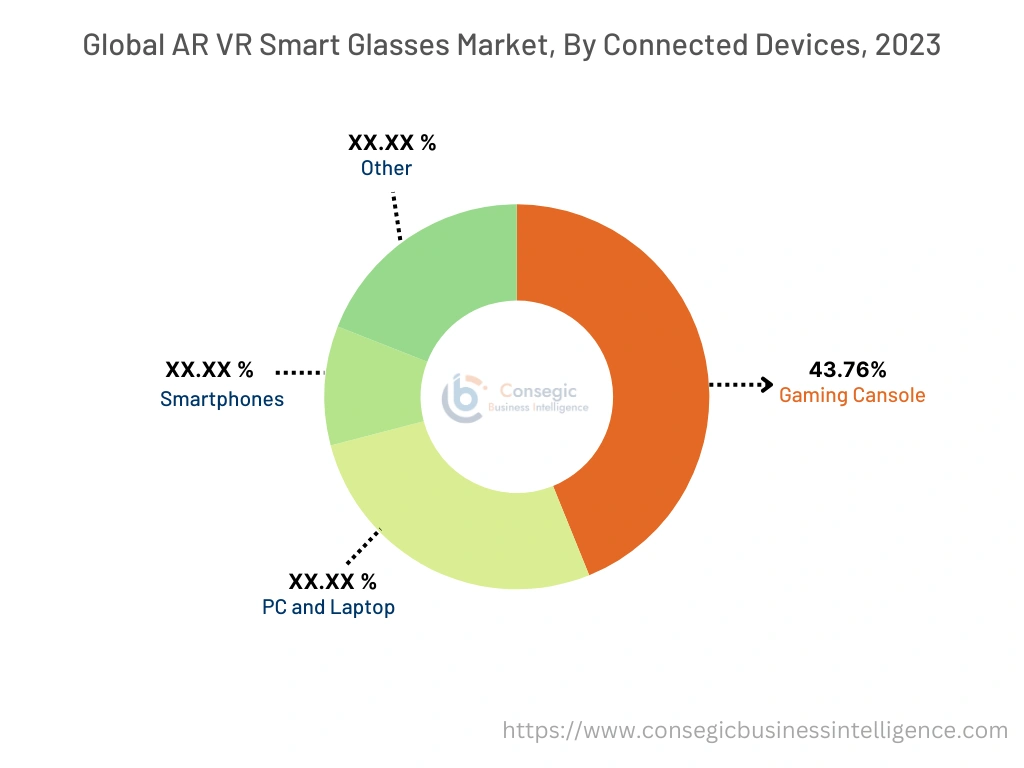
By Application:
Based on the application, the market is segmented into gaming, healthcare, education, military and defense, and others.
Trends in the application:
- The education sector has seen a significant increase in the utilization of AR and VR smart glasses for remote learning and training.
- AR and VR Smart Glasses are transforming military and defense operations by improving training effectiveness, operational efficiency, and maintenance processes.
The gaming sector accounted for the largest revenue share in the year 2023.
- This dominance is attributed to the immersive and interactive experiences offered by AR and VR smart glasses that are highly desired in gaming. The rapid technological advancements in the gaming sector, including improved graphics and lifelike virtual environments, have also contributed to this trend.
- Additionally, as per the analysis, the growing consumer interest in immersive gaming and the widespread acceptance of AR and VR technologies in the gaming sector has further propelled the market expansion.
- In March 2024, The Premier League entered a four-year partnership with Rezzil, a Manchester-based virtual reality (VR) software developer known for creating sports gaming software. The goal of this community effort is to invent a VR game in which supporters can feel themselves on the field where they are playing together with their popular players of the Premier League.
- Thus, the gaming sector is driving the AR and VR smart glasses market trends.
The healthcare sector is anticipated to register the fastest CAGR growth during the forecast period.
- The healthcare sector is driven by the rapid adoption of AR and VR technologies for various applications such as patient treatment, surgery planning, and medical education.
- Moreover, the sector is further fueled by the rising use of AR and VR in surgical procedures for their precision and efficiency, and the revolutionizing impact of these technologies on medical education.
- Additionally, the growing integration of connected devices in healthcare is also contributing to the market.
- In March 2024, Fresenius Medical Care introduced an AR-based training application for medical staff in Intensive Care Units (ICUs). This innovative approach combines digital learning with hands-on training on the continuous kidney replacement therapy system. It aims to reinforce initial training and support new staff, addressing the high turnover of specialists in intensive care nursing.
- Therefore, the healthcare sector is anticipated to boost the market demand during the forecast period.
Regional Analysis:
The regions covered are North America, Europe, Asia Pacific, Middle East and Africa, and Latin America.
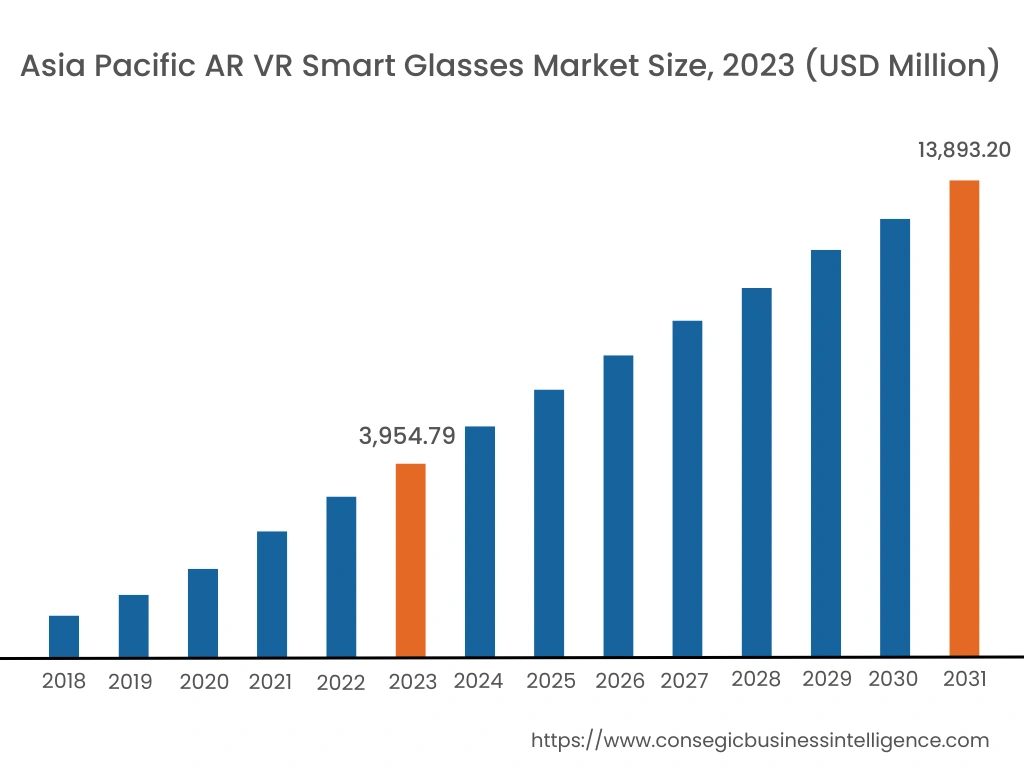
North America is estimated to reach over USD 19,374.49 Million by 2031 from a value of USD 5,600.60 Million in 2023 and is projected to grow by USD 6,440.03 Million in 2024. AR and VR smart glasses are mainly driven by their deployment in gaming, healthcare, and other industries.
- In June 2024, Vuzix Corporation, a leading provider of smart glasses and Augmented Reality (AR) technology, announced a strategic partnership with Avegant, a leader in light engine technology. The collaboration will result in an efficient, full-color, mass-manufactural, and lightweight AR display module, intended as an optical reference design for consumer smart glasses.
Furthermore, factors including technological advancements, increased consumer demand for immersive experiences, and supportive government policies are projected to drive the AR and VR smart glasses market growth in these regions during the forecast period.
Asia Pacific region was valued at USD 3,954.79 Million in 2023. Moreover, it is projected to grow by USD 4,553.44 Million in 2024 and reach over USD 13,893.20 Million by 2031. Out of this, China accounted for the maximum revenue share of 31.5%.
The Asia Pacific region's growing consumer electronic sector offers lucrative growth prospects for the market. Additionally, the surge in demand for immersive virtual experiences and remote collaboration tools due to the COVID-19 pandemic is propelling the market of AR and VR smart glasses in the region.
- In February 2023, Xiaomi, a global leader in consumer electronics and smart manufacturing, launched the Xiaomi Wireless AR Glass Discovery Edition. It offers enhanced connectivity with Snapdragon Spaces-ready smartphones, supports a wide range of applications for larger displays, and introduces advanced inter-device compatibility features.

As per the AR and VR smart glasses market analysis, Europe is anticipated to witness substantial growth that is backed by the increasing adoption of AR and VR technologies in various sectors such as the education and healthcare sectors. Companies invest in innovative technologies to cater to the surging demand for these glasses across the region.
The Middle East, Africa, and Latin America are expected to grow at a considerable rate due to increasing investments in digital infrastructure and other sectors in countries like Brazil, and UAE, among others.
AR and VR Smart Glasses Market Competitive Landscape:
The AR and VR smart glasses market is highly competitive with major players providing products to the national and international markets. Key players are adopting several strategies in research and development (R&D), product innovation, and end-user launches to hold a strong position in the market. Key players in the AR and VR smart glasses industry include-
- Meta (U.S)
- HTC Corporation (Taiwan)
- Microsoft Corporation (U.S)
- Samsung Electronics Co ., Ltd. (South Korea)
- Sony Corporation (Japan)
- Apple Inc.(U.S)
- Avegant Corp. (U.S)
- NVIDIA (U.S)
- Magic Leap (U.S)
- Epson America, Inc. (U.S)
Recent Industry Developments :
Product Launches
- In September 2023, Meta announced the launch of the new generation of Ray-Ban Meta smart glasses, developed in collaboration with EssilorLuxottica. These upgraded glasses offer enhanced audio and camera capabilities, over 150 unique frame and lens combinations, and a lighter, more comfortable design.
- In February 2023, Nubia unveiled its augmented reality eyewear, the Nubia Neovision Glass, marking a significant step in its strategic positioning in the 5G+XR field. It supports 0-500° myopic adjustment and can connect to a variety of devices including mobile phones, tablets, laptops, game consoles, drones, and more. It offers a plug-and-play experience and can connect to phones without a DP port via a standard projection box.
Mergers & Acquisitions
- In March 2023, ZEISS took full ownership of the joint venture Tooz Technologies, originally co-founded with Deutsche Telekom in 2018, in response to the burgeoning market potential for augmented reality (AR) and virtual reality (VR) glasses. Previously, each partner held a 50% stake in the start-up, which specializes in developing high-tech optics for augmented reality. By combining their expertise in optics, optoelectronics, and connectivity, ZEISS and Deutsche Telekom have successfully developed fully integrated solutions for smart glasses.
Partnerships & Collaborations
- In June 2023, T-Mobile and Google Cloud announced a joint venture, where the two companies would collaborate to combine 5G advanced network solutions with Google's powerful edge computing abilities. The project's goal is for companies to provide brand new services to customers, as well as experimentation in some of the most promising connected areas possible like AR/ VR experience.
- In May 2023, Wisear and DigiLens leading providers of AR solutions, announced a strategic partnership to revolutionize the work of frontline workers with top-tier AR enterprise solutions. The partnership, which combines DigiLens' ARGO smart glasses and Wisear's neural interface-powered earphones, aims to enhance safety, efficiency, and collaboration across various industries.
AR and VR Smart Glasses Market Report Insights :
| Report Attributes | Report Details |
| Study Timeline | 2018-2031 |
| Market Size in 2031 | USD 54,270.29 Million |
| CAGR (2024-2031) | 16.7% |
| By Type |
|
| By Connected Devices |
|
| By Application |
|
| By Region |
|
| Key Players |
|
| North America | U.S. Canada Mexico |
| Europe | U.K. Germany France Spain Italy Russia Benelux Rest of Europe |
| APAC | China South Korea Japan India Australia ASEAN Rest of Asia-Pacific |
| Middle East and Africa | GCC Turkey South Africa Rest of MEA |
| LATAM | Brazil Argentina Chile Rest of LATAM |
| Report Coverage |
|
Key Questions Answered in the Report
How big is the AR VR Smart Glasses Market? +
The AR/VR Smart Glasses Market was valued at USD 15,724.31 Million in 2023 and is projected to grow to USD 54,270.29 Million by 2031.
Which is the fastest-growing region in the AR VR Smart Glasses Market? +
Asia-Pacific is the region experiencing the most rapid growth in the AR VR Smart Glasses Market.
What specific segmentation details are covered in the AR VR Smart Glasses report? +
The AR VR Smart Glasses report includes specific segmentation details for type, connected device, application, and region.
Who are the major players in the AR VR Smart Glasses market? +
The key players in the AR VR Smart Glasses market are Meta (U.S), HTC Corporation (Taiwan), Apple Inc. (U.S), Microsoft Corporation (U.S), Samsung Electronics Co., Ltd. (South Korea), Sony Corporation (Japan), Avegant Corp. (U.S), NVIDIA (U.S), Magic Leap (U.S), and Epson America, Inc. (U.S).
